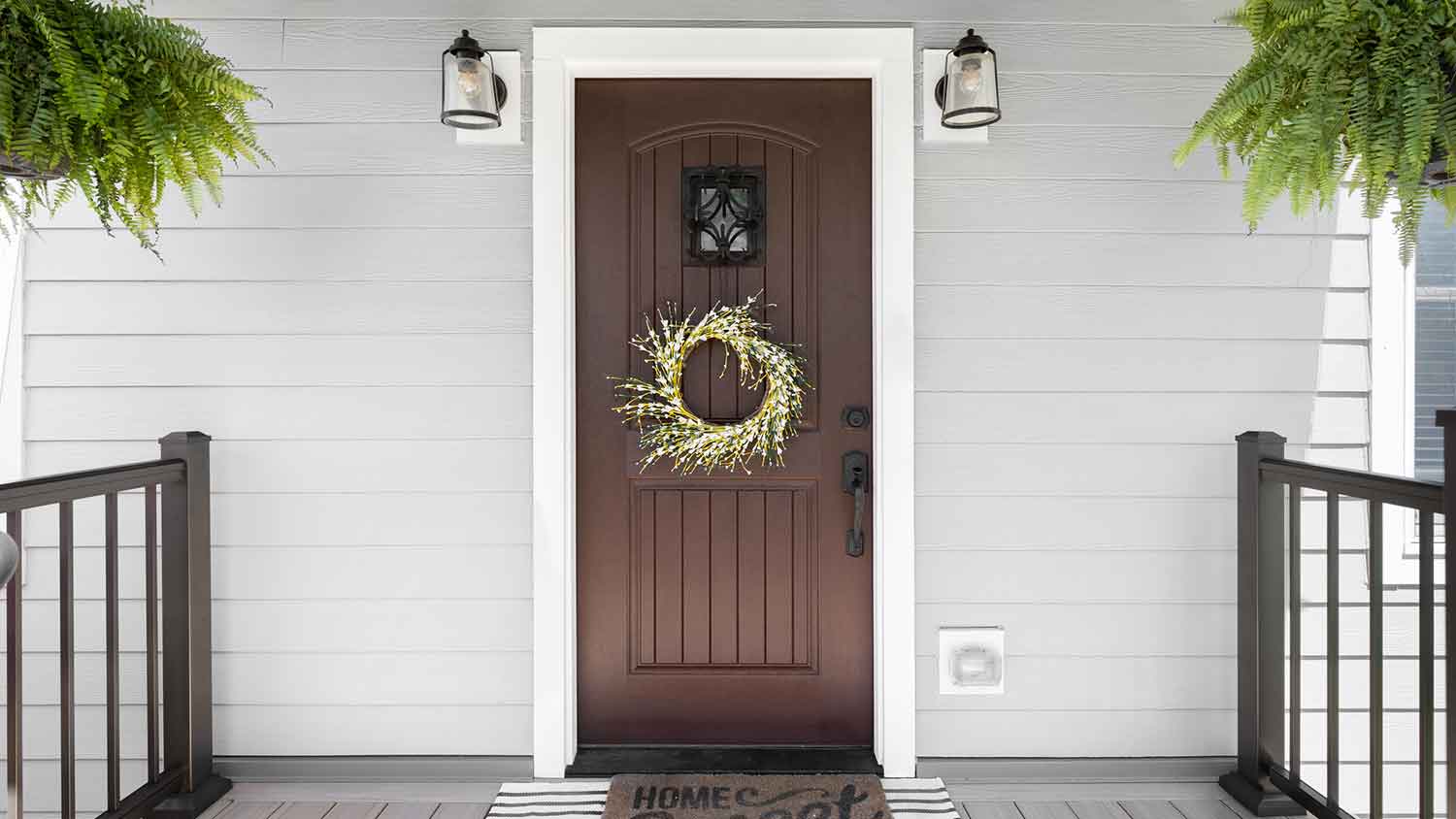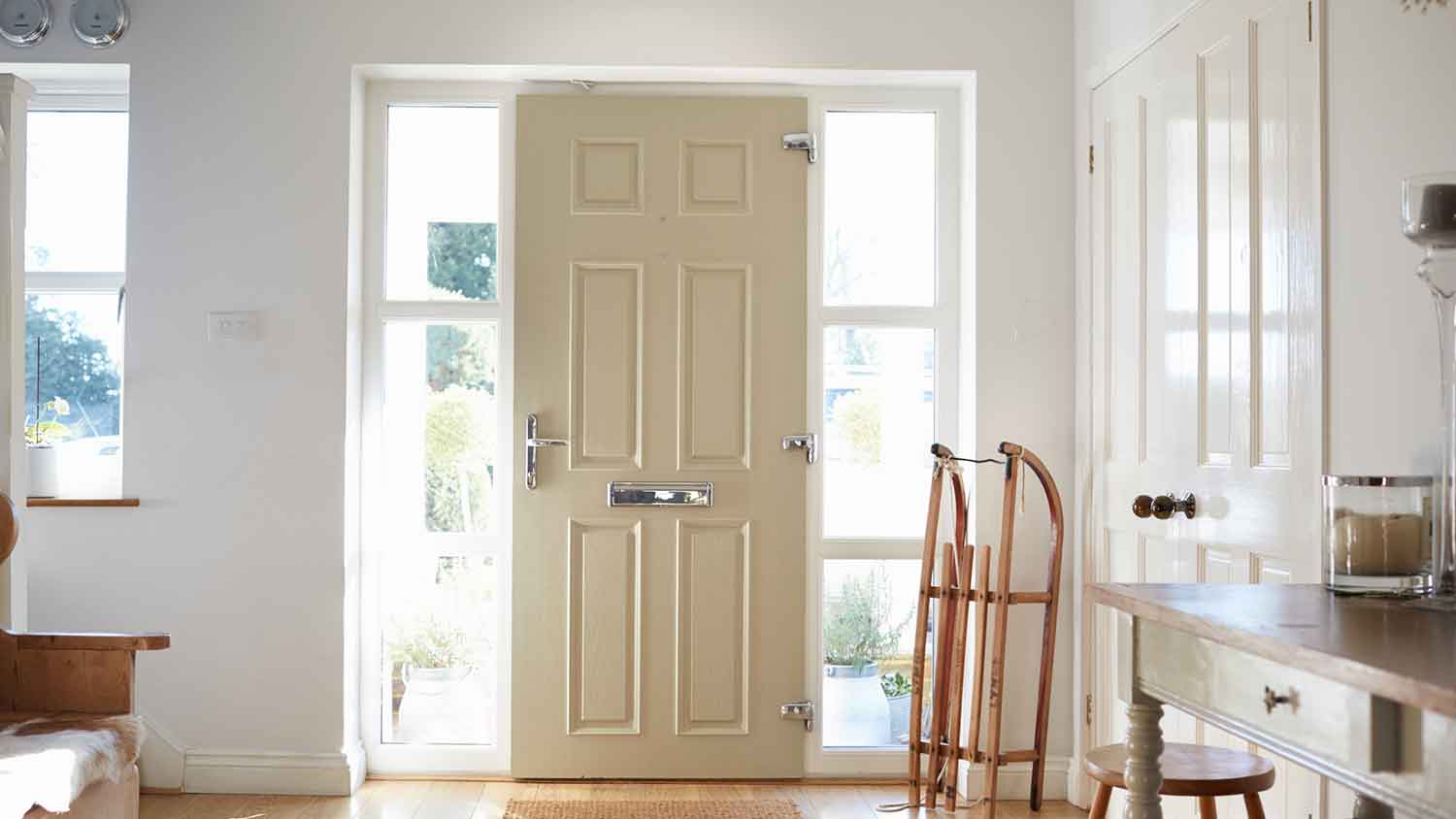
Screen door installation costs depend on size, type of frame material, and the number of doors. Here’s everything you need to know.
Fiberglass doors offer ease and beauty with just a few drawbacks


Fiberglass is exceptional for temperature regulation and weather-resistance.
Almost no maintenance is needed to keep fiberglass beautiful.
Fiberglass doors are comparable in cost to wooden doors.
As you contemplate your options for a new door installation cost that can range from $500 to $1,970, fiberglass is likely at the top of the list. While a fiberglass door offers pros like easy maintenance, durability, energy efficiency, and versatility, it does come with shortcomings like higher prices, fewer aesthetic choices, and less security. Let's work it all out with this rundown of the pros and cons of fiberglass doors.
Fiberglass doors are made of compression-molded fiberglass designed for strength and durability. The process allows fabricators to make doors match various aesthetics. In fact, many mainstream fiberglass doors have a slightly grainy texture that mimics the appearance of wood.
Fiberglass doors aren't actually solid. The surfaces you see are "skins." During production, two individual sides are placed on a frame. The hollow middle section is then filled with insulating foam.
| Fiberglass Door Pros | Fiberglass Door Cons |
|---|---|
| Versatility | Higher cost |
| Durability | Fewer aesthetic choices |
| Energy efficiency | Less security |
| Easy to maintain |

Here's what makes fiberglass one of the most popular options.
There's practically no limit to the design potential with fiberglass doors. From contemporary styles to farmhouse looks, manufacturers of fiberglass doors make their products in a variety of finishes representing all the popular home looks. What's more, fiberglass glass doors can be painted to match your home's unique aesthetic.
Fiberglass doors are generally considered more durable than other types of entry doors. They are resistant to rotting, warping, and shrinking due to weather. In addition, fiberglass' weather-resistant properties prevent your door from swelling in high heat and humidity the way that wooden entry doors often do. The lack of shrinkage that occurs during colder months means you don't have to worry about drafts caused by your door "shriveling up" when temperatures drop. Fiberglass holds up beautifully against intense sun, heavy rains, and whatever else Mother Nature will throw at your front door.
Fiberglass has strong insulation that makes these doors more efficient compared to wood or steel doors. That means that more of your heated or air-conditioned air will stay in your home.
One of the big advantages of fiberglass doors is that they're easy to maintain. Unlike wood doors, fiberglass doors don’t need to be stained or repainted. Generally, mild soap and water will be enough to remove any dirt or fingerprints that accumulate. Some homeowners do choose to add a clear varnish or paint for fiberglass doors to prevent potential chipping or peeling as time goes on. However, fiberglass doors generally stay looking fresh and new for much longer than other doors.

While fiberglass doors make life easy for homeowners, there are some disadvantages that could cause you to consider alternatives.
Fiberglass doors typically cost anywhere from 25% more to twice as much as alternatives. When you're looking at fiberglass versus wood doors, the cost is nearly equal, with both costing between $200 and $5,000 on average. However, the comparison for fiberglass versus composite wood is closer to $200 to $5,000 for fiberglass and $200 to $900 for engineered wood. Fiberglass is also significantly more expensive than steel. When comparing fiberglass versus steel doors, steel costs nearly half as much at $150 to $1,400.
While there are many beautiful fiberglass doors that mimic the look of real wood, the effect may not translate to all door styles. In some homes, there's simply no way to get the rich look of natural wood. What's more, homeowners may not be able to find specialty looks that match luxury aesthetics.
In general, a fiberglass door is easier to breach or "kick in" compared to something like steel or solid wood. However, that doesn't mean that fiberglass doors are necessarily "easy" to break. This is only a concern if you live in an area with a high rate of break-ins or burglaries because the difference could make your home a more desirable target for seasoned criminals.
If you're not sure if fiberglass is the right fit for your home, consider these alternatives:
Steel: A steel door is a budget-friendly alternative to fiberglass that offers durability and protection. However, rusting and denting do add to maintenance concerns with this option.
Wood: Real solid wood doors offer unparalleled aesthetic charm. They can be customized to match your home using stains and hardware. While beautiful, wooden doors do require regular maintenance to prevent cracking and warping.
Composite Wood: Offering the look of wood doors for less, composite doors are generally durable and easy to maintain. However, they are more susceptible to damage from weather than almost any other door option.
Fiberglass is the option most homeowners settle on for its midline pricing, durability, and easy maintenance. With the exception of homeowners who are restoring historic or era-driven homes, most people will find that fiberglass designs available fit in perfectly with their homes. Additionally, fiberglass is a great option if you're trying to avoid obscuring your beautiful new front door with a storm door. Due to its durable construction and natural weatherproofing qualities, fiberglass doesn't need to be protected behind a glass storm door. The best way to ensure that a new fiberglass door is properly secured is to get it professionally installed by a local door installation company.
From average costs to expert advice, get all the answers you need to get your job done.

Screen door installation costs depend on size, type of frame material, and the number of doors. Here’s everything you need to know.

The cost to install a pocket door includes a few more line items than other designs. Here's what to expect from pocket door costs at each stage in the process.

Sprucing up the barn or adding a rustic touch to your home? Use this guide to estimate barn door installation costs, so you can budget for your next project.

If you’re new to an inclement-weather-prone area, it might be time to learn how to install a storm door. Explore our straightforward eight-step guide here.

French doors add elegance and convenience to your home. Learn how to install French doors in just a few straightforward steps.

If you are wondering who to hire to install weather stripping on your door, we share the best experts for fixing those pesky air gaps.